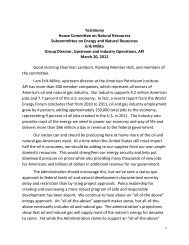Mr. Clint Georg - The House Committee on Natural Resources ...
Mr. Clint Georg - The House Committee on Natural Resources ...
Mr. Clint Georg - The House Committee on Natural Resources ...
You also want an ePaper? Increase the reach of your titles
YUMPU automatically turns print PDFs into web optimized ePapers that Google loves.
timber sales in this area requires adding just 11 people to the current staff. This modestinvestment would be paid back from direct payments for the timber sold, the reduced costsof stewardship c<strong>on</strong>tracts, and the potential savings from reduced wildfire risks. <str<strong>on</strong>g>The</str<strong>on</strong>g>commitment for l<strong>on</strong>g-term access to this timber is necessary to justify the l<strong>on</strong>g-term natureof these investments and additi<strong>on</strong>al investments such as those which hold great promise forusing bio-mass from the forest for generating clean-renewable energy. But thoseinvestments are not justified without a stable, l<strong>on</strong>g-term supply of timber.2. <str<strong>on</strong>g>The</str<strong>on</strong>g> timber sales must be ec<strong>on</strong>omically viable. Viability is determined by the compositi<strong>on</strong>of the timber being sold and the performance requirement under those c<strong>on</strong>tracts.Lodgepole pine, the type of tree most widely infested, has relatively low commercial appeal,so the timber c<strong>on</strong>tracts must be written in a way that harvesting is not cost prohibitive.3. <str<strong>on</strong>g>The</str<strong>on</strong>g> industry must comply with current envir<strong>on</strong>mental regulati<strong>on</strong>s, but it needs protecti<strong>on</strong>from malicious envir<strong>on</strong>mentalist acti<strong>on</strong>s such as those that destroyed the timber industryin other parts of the country. To understand this, we need look no further than Ariz<strong>on</strong>awhere in 1996 an envir<strong>on</strong>mental group w<strong>on</strong> a court injuncti<strong>on</strong> that temporarily shut downlogging <strong>on</strong> all nati<strong>on</strong>al forests in Ariz<strong>on</strong>a and New Mexico. As a result, the Ariz<strong>on</strong>a timberindustry is now largely extinct. Since then, Ariz<strong>on</strong>a has had the five largest forest fires in itshistory. For more than a decade, that state’s government has desperately been trying withfinancial incentive and other means, to reestablish an Ariz<strong>on</strong>a timber industry but has beenunsuccessful – it simply is not ec<strong>on</strong>omically feasible to replace what was lost. In Colorado,what remains of the timber industry must be viewed as a precious resource for the state.It needs to be protected, because if the industry, and in particular if these two mills, are lost,like in Ariz<strong>on</strong>a, they will not be rebuilt.<str<strong>on</strong>g>The</str<strong>on</strong>g>re is an opportunity for the last two large sawmills in this regi<strong>on</strong>, using effective private enterprise,to aid in the near and l<strong>on</strong>g-term timber management needs of Colorado and Wyoming. For this tohappen, it is essential for the US Forest service to provide an adequate, l<strong>on</strong>g-term stable supply oftimber, under ec<strong>on</strong>omically viable terms. It is also essential that the timber industry be providedprotecti<strong>on</strong> from an unreas<strong>on</strong>able use of envir<strong>on</strong>mental regulati<strong>on</strong>s such as that which has destroyedother regi<strong>on</strong>al timber industries.Thank you for your invitati<strong>on</strong> to speak at this hearing. Your leadership is a critical comp<strong>on</strong>ent in thefuture of this industry. I would be happy to answer any questi<strong>on</strong>s.FOLLOWING IS INFORMATION SUPPORTING THE STATEMENTS ABOVE:HISTORY OF THE COLORADO TIMBER INDUSTRYA <strong>on</strong>ce vibrant industry, built up over a century, has been decimated due to the lack of access toColorado’s abundant timber resources.To understand the current crisis facing the forests in Colorado, it is helpful to review the history of theColorado timber industry. <str<strong>on</strong>g>The</str<strong>on</strong>g> Colorado timber industry began in the 1860s when vast tracts of virginforests were harvested to support mining, railroads and housing development in the state. FollowingWorld War II, with str<strong>on</strong>g housing markets and public policy encouraging timber producti<strong>on</strong> <strong>on</strong> Nati<strong>on</strong>alForests, timber harvests for industrial products in the Four Corners States increased from about 7002
















